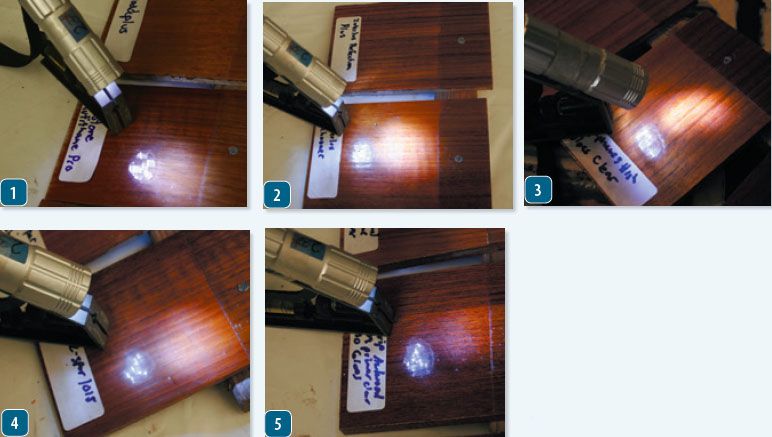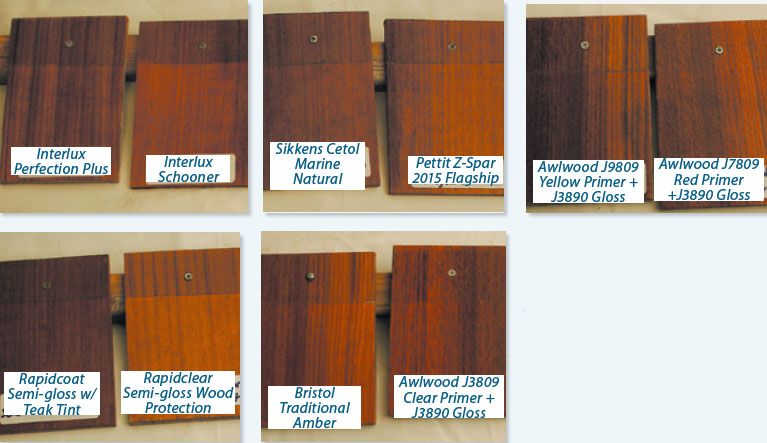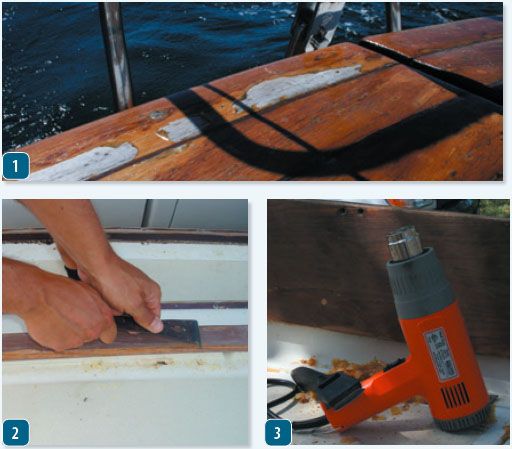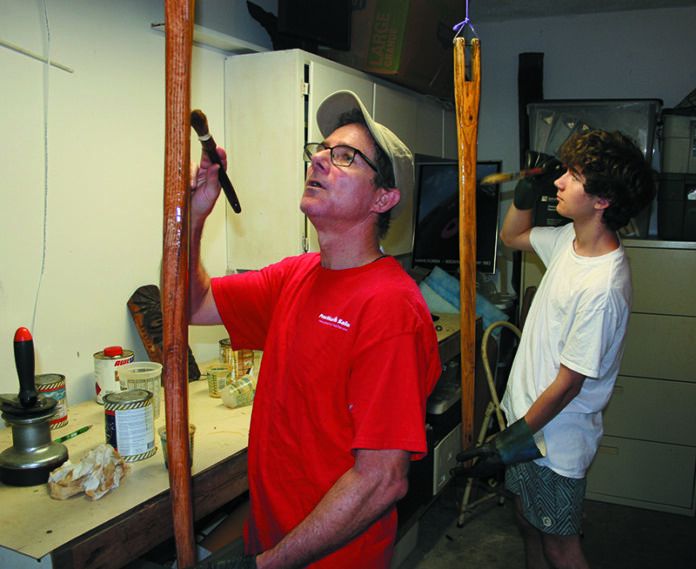Boxed and stored as PS went through three office moves in a short time frame, the wood samples we varnished in late 2015 finally went into service three years after they were varnished.
The coatings makers tell us that our results should be little different than those of a sailor who immediately exposes their woodwork to the weather, but for the sake of accuracy, consider this to be a test of briefly aged, varnished teak after two years of exposure.
Perhaps the best result of this delay was to save us about 20 percent on the retail price—as all of the products have become more expensive. Of the 23 finishes that were submitted for our test, four were no longer available. For our most recent long-term test of panels that went directly out into the sun, see our the “Exterior Wood Finish Test Two-year Update” in the September 2011 issue
WHAT WE TESTED
We focused on marine specific coatings, although one product, Woodplus, has effectively retreated back to land. There are a total of 18 wood finishes in the test. Represented makers include Epifanes, Interlux, Pettit, Awlgrip, Bristol, Woodplus, and Bonstone. See the “How We Tested,” section on pages 8 and 9 for details on application and evaluation.
Sunlight and weathering begins to take its toll as panels enter third year of exposure.

1. Bonstone Nautithane Pro
2. Interlux Schooner
3. Epifanes High Gloss Clear
4. Pettit Z-spar 1015
5. Awlgrip Awlwood J3809 Clear Primer with J3890 Gloss.
The products were applied according to maker instructions, except with regard to number of coats. To keep a degree of consistency, testers applied four coats of each product that called for more than three coats—including those that called for four, five, six, etc. coats. We did this to even the playing field in a way, as far as application, and to simplify application. That being said, in the real-world, you should always follow maker’s instructions, and skipping a required coat or two means you’re cheating the finish of some UV protection; the more coats of varnish you put on, the more protection and durability you will get.
For ease of application ratings, testers considered how smoothly the product flowed on, how complete the instructions were, and how simple the preprocess was. For example, products that did not require sanding between coats were rated higher than those that called for sanding between every coat; re-coat times, dry times, thinning, etc. all factored into the application rating.
To rate the initial gloss, testers used a multi-bulb LED flashlight in a dark room. The coated test panels that showed a sharp reflection of the separate LED bulbs rated Excellent, while those that reflected only a single light beam weren’t rated as highly. Differences were so tiny that testers resorted to a plus-and-minus rating system to denote the negligible degrees of variation in the first round of testing. After two years, the distinctions were more apparent.
For the long-term test, the panels have been mounted outside our office in Sarasota, FL on a south facing wood frame set at a 45-degree angle. Testers covered a section of each test panel to preserve its original gloss and color. This covered area provides us a baseline for comparing the finishes’ coating integrity, and their ability to retain gloss and color over time.


AWLGRIP AWLWOOD
AkzoNobel, the makers of Interlux bottom paints and Awlgrip paint released its Awlwood MA wood coating system in 2014. This fast-curing, two-step system involves a coat of primer (clear, yellow, or red) plus multiple coats of a topcoat (satin or gloss). You can add a special reducer to control flow. The two-step system is engineered to allow multiple layers of a high-solid coating to be applied without sanding between coats, as long as the previous coat is sufficiently cured. The initial tinted layers enhance the woods natural coloring and penetrate the wood to ensure a uniform substrate. The gloss provides UV protection.
After 24 months in the Florida sun all three of the Awlwood samples maintained outstanding color retention—the difference between the exposed and unexposed areas was nearly indistinguishable. All three samples also maintained superior gloss. The difference between the primer colors was barely noticeable.
Bottom Line: Recommended. For ease of application, color preservation, gloss, and durability Awlwood is hard to beat. All three samples were clearly among the best in our comparison. Although recoat times are quick, the overall time required is comparable to others in this group.
| PRODUCT | PRICE | COATS* | RECOAT TIME* | SANDING | APPLICATION EASE | COLOR RETENTION | INITIAL GLOSS | FINAL GLOSS |
|---|---|---|---|---|---|---|---|---|
| ONE-PART VARNISHES | ||||||||
| EPIFANES CLEAR VARNISH HIGH GLOSS | $43/1000 ml | 7-8 | 24 hours | Light sand | Good | Good | Excellent | Very Good |
| INTERLUX SCHOONER GOLD | $48 / qt. | 6-8 | 8-16 hours | Light sand between every other coat | Good | Good | Good | Very Good |
| INTERLUX COMPASS CLEAR | $30 / qt. | 5-7 | 8-16 hours | Light sand between every other coat | Good | Good | Excellent | Good |
| INTERLUX SCHOONER | $32 / qt. | 5-6 | 8-12 hours | Light sand | Good | Good | Excellent | Good |
| PETTIT Z-SPAR 2015 FLAGSHIP | $37 / qt. | 4 | 18 hours | Light sand | Good | Very Good | Excellent | Very Good |
| PETTIT Z SPAR 1015 CAPTAIN’S VARNISH | $32 / qt. | 4 | 12 hours | Light sand | Good | Very Good | Excellent | Very Good |
| VARNISH ALTERNATIVES | ||||||||
| EPIFANES RAPIDCOAT SEMI-GLOSS TINTED | $45 / 750 ml | 4-5 | 5-6 hours | No | Excellent | Excellent | Good | Fair |
| EPIFANES RAPIDCLEAR SEMI-GLOSS | $36 / 750 ml | 4-5 | 5-6 hours | No | Excellent | Fair | Good | Fair |
| EPIFANES WOODFINISH GLOSS | $43 / 1000 ml | 5-7 | 24 hours | Recommended, not required within 72 hrs. | Good | Good | Excellent | Very Good |
| INTERLUX SIKKENS CETOL MARINE NATURAL | $39 / qt. | 2 | 24 hours | No | Excellent | Excellent | Good | Fair |
| WOODPLUS ULTRA 275 HONEY GOLD | $28 / liter | 2-3 | 4-6 hours | No | Excellent | Good | Good- | Fair |
| MULTI-PART AND MULTI-STEP VARNISH SYSTEMS | ||||||||
| EPIFANES PP VARNISH EXTRA | $190 / 2000 ml | 4 - 6 | 2 hours | No | Excellent | Good | Good+ | Good |
| INTERLUX PERFECTION PLUS | $85 / qt. kit | 5 - 7 | 4-6 hours | Yes | Good | Good | Excellent | Excellent |
| BONSTONE NAUTITHANE PRO URETHANE COATING | $80 / 1.5 qt. kit | 4 - 6 | 3-5 hours | No | Good | Very Good | Excellent | Excellent |
| BRISTOL TRADITIONAL AMBER URETHANE HIGH GLOSS | $73 / qt. kit | 6 | 1-24 hrs.; varies by app method | Before last coat | Excellent | Excellent | Excellent | Excellent |
| AWLGRIP AWLWOOD J3809 PRIMER CLEAR + J3890 GLOSS | $180 ($85 + $75) | 9 (1 primer + 8 gloss) | 1-3 hours | Recommended, not required if within 24 hrs. | Excellent | Excellent | Excellent | Excellent |
| AWLGRIP AWLWOOD J9809 PRIMER YELLOW + J3890 GLOSS | $180 ($85 + $75) | 9 (1 primer + 8 gloss) | 1-3 hours | Recommended, not required if within 24 hrs. | Excellent | Excellent | Excellent | Excellent |
| AWLGRIP AWLWOOD J7809 PRIMER RED + J3890 GLOSS | $180 ($85 + $75) | 9 (1 primer + 8 gloss) | 1-3 hours | Recommended, not required if within 24 hrs. | Excellent | Excellent | Excellent | Excellent |
BONSTONE NAUTITHANE PRO
Bonstone clearly has found the secret to giving amateurs a shot at great brightwork without breaking the bank. This two-part, high-gloss urethane coating was a newer formula than the previous one, which rated Excellent in 2011.
Even with our throw-away brushes, the coating self-leveled into a smooth surface. The maker was hoping the new formula would be more durable, more UV resistant, and easier to apply than their previous formula, and so far it seems they met their mark.
In terms of color retention, the clear coating’s exposed area was a slightly darker hue than the original application, a surprise since most others shifted lighter. The color shift—combined with the excellent gloss—actually made for a rich, aesthetically pleasing hue.
Bottom line: Recommended. If a mirror-like gloss is what you value in your brightwork, the new and improved Nautithane Pro is a fine two-part choice at an affordable price.
BRISTOL FINISH
An acrylic urethane system made by Lalandii Coatings, Bristol Finish comes recommended by PS readers and has performed well in previous tests. We tested the Bristol Finish Traditional Amber two-part varnish, which had been reformulated since the 2011 test.
The instructions offer three application methods to choose from: the weton- wet method, dry method, and the practical method. The practical method, which we of course chose, minimized sanding, making Bristol one of the easier two-part finishes to apply.
Color retention was very good. The unprotected section lightened to a more golden color than the original, indicating UV penetration, but not unpleasant. Gloss was excellent. A few dimples due to our hasty application marred the near perfect reflection, but anyone who wasn’t varnishing 20-plus samples in a day with a throwaway brush would not have this problem.
Bottom line: Budget Buy. Bristol Finish’s new finish lives up to its name. For best results, we’d opt for the sanding at least before the final coat.
Should we varnish cabin soles? What about stained veneer?
First address the stains. If there is any finish remaining, you need to remove it by carefully sanding (see adjacent article).
For large stains, mix 16 ounces oxalic acid crystals with 1 gallon very hot water; stir until crystals dissolve, then paint mixture onto stained wood using a foam brush or small sponge, apply several coats until solution is used up or it cools off. Let it sit overnight.
If you’re satisfied, wash the bleach with a neutralizer (3 oz. Borax to 1 gal. hot water; or vinegar or soda ash) and then rinse thoroughly (acid left in wood can ruin finish). If more bleaching is needed, repeat until you are satisfied.
For the veneer-and-plywood sole we recommend using a satin-finish, onepart polyurethane varnish to protect the thin veneer and plywood, and adding some nonskid aggregate to the final coats to add traction. If you don’t want to use the aggregate on the whole sole, at least add it at the base of the companionway and outside the head, where a sole is most likely to get wet.
If you opt to go with a high-gloss varnish be sure to use a flattening agent with it, or, in the case of Epifanes High Gloss, replace the two final coats with the company’s Rubbed Effect Interior Varnish. Having a satin or matte finish helps to minimize slipping.
For aggregate options, you have a few choices. We recommend using salt or crushed walnut shell powder with varnish, rather than the canned aggregate sold by marine paint makers and often used with deck paints. Others prefer pumice or finely ground sand. Both the walnut shell and salt methods are easy to touch up and re-apply.
You can find ground walnut shell powder at larger boat yards, paint supply companies, and Harbor Freight. After building up a uniform series of base coats and letting it cure, place strips of masking tape over the centerline of the holly strips, and then mix the powder in the final coat of varnish. This results in nonskid stripes that are near in color to the teak, with enough of the sole left glossy to add a warm feel to the cabin.
The “salted sole” method starts after your base coats have fully cured. Next, mask off the areas to be made nonskid, and lay on a heavy coat of the same finish. Heavily sprinkle it with coarse salt; we use a grinder held 2 to 3 feet above the surface. Start with a light coat, moving back and forth until a uniform coating is obtained.
Once the coating dries, rinse away the salt crystals with fresh water. Because its water-soluble, the salt disappears, leaving a surface stippled with tiny indentation where the crystals once were. This offers traction without taking away from the finish.

EPIFANES
Few names are as synonymous with clear wood finishes than Epifanes. We tested five products: Clear high-gloss one-part varnish, Rapidcoat semi-gloss, Rapidclear semi-gloss, Woodfinish gloss varnish alternative, and the PP Varnish Extra two-part varnish.
A traditional varnish, Epifanes Clear Gloss Varnish has been popular in wooden- boat circles for many years because of its high gloss and wet, traditional finish. It flows well, and thanks to its tung-oil base, the finish is more flexible than non-spar varnishes. Color retention was Good, and gloss was Very Good.
The Woodfinish Gloss also has a tungoil and phenolic-modified-resin base. It has a slightly amber hue, but applies with a clear finish that looks similar to that of the Clear Gloss. It’s quicker to apply (fewer coats are required and there’s no sanding between coats within 72 hours). Woodfinish gloss, which testers rated Very Good, was the best among the Epifanes finishes, narrowly edging out the Clear Gloss. Color retention was Good, with nearly the identical degree of color shift as the Clear.
For ease of application, it is hard to beat Rapidcoat and Rapidclear. Quick drying dry times, fewer required coats with no sanding in between allow you to refinish a properly prepped surface in two days. Both coatings are semigloss finishes engineered to preserve the wood’s natural beauty, so the Fair gloss ratings for each product is to be expected. In terms of color retention, the slightly tinted Rapidcoat was the clear winner, reinforcing one of the findings of our test—tinted coatings and primers effectively stall the inevitable fading that comes with time in the sun.
A two-part alkyd resin/isocyanate, PP Varnish Extra is promoted as an exceptionally hard, fast drying, highbuild filler coating that benefits from a final clear coat with UV inhibitors. For ommends top-coating with two or more coats of Epifanes Clear Gloss Varnish, Epifanes Woodfinish Gloss, or Epifanes Polyurethane Clear Gloss Finish. We did not apply a topcoat, yet the finish still maintained Good gloss, and the color retention was better than all the Epifanes except the tinted Rapidcoat.
Bottom line: Each Epifane product has its niche, and performed up to our high expectations. For color retention, the tinted semi-gloss Rapidcoat, though dulled slightly, looks very much like it did on its first day. For lovers of gloss, look to the Clear High Gloss or the Woodfinish Gloss, which clearly stood out for their shine. If you want a durable, glossy substrate for your spars, tiller, or classic wooden blocks that take a beating, it might be worth emptying your wallet for the PP Extra, but we’d coat it with the Woodfinish or the Clear High Gloss. If you prefer a quick-to-apply lighter semi-gloss, go with Rapidclear, but expect to do regular maintenance coats in the tropics.
INTERLUX
We tested three new exterior varnishes from Interlux: Perfection Plus, a clear two-part polyurethane; Schooner Gold, a high-viscosity, quick-building varnish; and Compass, a fast-drying hybrid of classic tung-oil and polyurethane. We also tested the familiar standby Schooner coating, still favored by many purists.
The golden-colored Schooner Gold, with a higher viscosity than the original, touted advanced UV technology and extended durability. It also requires fewer coats, reducing application time and effort. Schooner Gold also doesn’t require sanding between coats, although it is recommended for a better finish. Compass Clear has a polyurethane base, presumably making it highly durable and abrasion resistant—good for spars and tillers. According to Interlux, Compass Clear also has additives for UV resistance plus stabilizers for long-term gloss and clarity. The clear finish shows the natural color of the wood, and all of the Interlux finishes excelled in this regard.
Interlux’s Cetol product line is well-known among boat owners who preprocess fer a low maintenance approach to teak coamings (think Island Packets). Cetol is an easy-to-apply synthetic coating with high solids to protect against UV. As the surface dulls, a quick pass with a 3M scrubber is all you need to recoat. In addition to our panels, we field-tested the Cetol Marine Natural Teak in a head-to-head against Awlwood MA Clear.
In terms of color retention, there was across-the-board consistency for both Schooners, Perfection Plus, and Compass. All showed moderate fading to a rich reddish hue, rating Good in color preservation. For gloss, Perfection Plus scored Excellent, with Schooner Gold, Schooner, and Compass in a near dead heat with Good ratings.
We got a nice surprise in our field test of Cetol Marine Natural Teak, which though not as glossy, is holding up well against the Awlwood MA, providing more affordable protection, yet still highlighting the wood’s natural grain.
Bottom Line: Perfection Plus was among our highest gloss varnishes, and Cetol’s Marine Natural Teak will win more Cetol fans. For pure varnish lovers, reliable Schooner shines, and for ease of application, Schooner Gold is a step up.
PETTIT
The two Pettit products in this test, 2015 Flagship and 1015 Captain’s Varnish, are both one-part varnishes from the company’s Z-Spar product line, and both were Recommended products at the 18-month mark in our last test.
Both the amber-colored Captain’s and the warm-hued Flagship are well-regarded as traditional spar varnishes, combining phenolic and alkyd resins with tung and linseed oils. Application is relatively easy. After two years, both showed Very Good gloss. Both retained color extremely well.
Bottom line: Pettit’s duo scored better than most in terms of color retention/ They were both equally glossy, with a rich shine. The 1015 Captain’s Varnish offers good value for the price, earning a Budget Buy rating.
WOODPLUS ULTRA 10
Makers of high performance architectural wood coatings, WoodPlus Coatings sent us a sample of Marine 301 Honey Gold. Described as a “100 percent acrylic coating,” it is now called Ultra 10 in the Honey Gold 275 tint. Woodplus says this solvent-free product offers better UV resistance than previous Woodplus products we have tested.
This was one of the lighter tinted coatings that we tested. Weathering had lightened the color, but the satin finish was unchanged. Woodplus called for fewer coats, and the surface was smooth and still intact.
Bottom line: A Budget Buy for those who like tinted coatings that seek to preserve the wood’s natural look.
CONCLUSION
As mentioned in the introduction and in the “How We Tested”, your choice in wood finish often boils down to preference.
In terms of one-part, “traditional” varnishes, Pettit’s Flagship and Epifanes Clear High Gloss are neck and neck. Epifanes scores in the gloss category, while both the Pettit varnishes did better at preserving original color.
If you want your wood to maintain the wet look of a high gloss finish, you have several choices:
1. any of the Awlwood coatings, which lost almost zero gloss or color;
2. the Bristol Traditional Amber Urethane high gloss, which lost no gloss that and only a little color;
3. Interlux Perfection Plus had slightly higher gloss than the Bristol product, but you had to look hard;
4. Epifanes PP Varnish Extra topped with Epifanes Clear High Gloss or another recommended Epifanes coating.
If you are don’t mind tint and don’t want a glossy finish, you have several easy-to-apply options for a durable finish. Among the varnish alternatives, Cetol Marine Natural is doing yeoman’s work in the field. In terms of coating integrity, it is still standing toe-to-toe with the Awlwood MA J3890 in our field test. In our gloss test, Epifanes Woodfinish Gloss was shinier than the other synthetic teak treatments. For color retention, Cetol Marine Natural, Epifanes Rapidcoat were about equal, followed by the lighter-hued Woodplus Ultra Honey Gold 275.

A year-long furlough from maintenance coats and touch ups can be just enough to push your unprotected varnish over the edge into failure territory, bringing yet another unexpected project this season. Some varnishes are easier to remove than others. The two-part urethanes are notoriously tenacious.
Takedown methods for varnish include sanding (for removing thinner coatings), dry scraping, or heating and scraping (best for thicker finishes), and chemical stripping. Heat guns and strippers should be used with caution around painted and fiberglass surfaces; rinse the stripper thoroughly from the wood as any residue will cause adhesion problems.
For varnish alternatives: Sand with 80 grit and move up to 220, clean, and re-coat. Industry tests have shown that adhering to a tighter scale of increasing grit gets the job done quicker; a 80-120- 150-200 step down is more productive than going directly from 100 to 220. Although you may be tempted to use courser grit, you run the risk of shaving away precious teak.

AWLGRIP, 888/355-3090,
BONSTONE, 800/425-2214,
BRISTOL, 855/423-8009,
EPIFANES, 207/354-0804,
INTERLUX, 800/468-7589,
PETTIT Z SPAR, 800/221-4466,
WOODPLUS COATINGS, 905/729-3476,







































I applied Bristol Traditional Amber finish to the brightwork on my CHB 34 and so far am very disappointed. After only a couple of months white areas and spots began appearing. Bristol representatives say the problem is black mold but I applied strictly according to the instructions. The teak was thoroughly sanded and cleaned. I had a wood expert/cabinet maker on hand helping with the prep work to make sure it was done properly. I think something was wrong with this particular batch of finish.